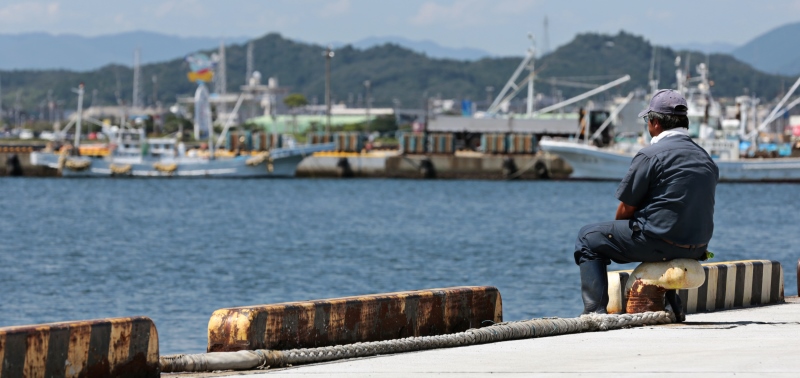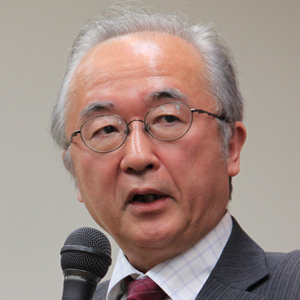
Six years after the Fukushima nuclear accident, the local fishing industry remains deeply depressed, even though Fukushima seafood is certifiably safe for consumption. To avert a downward spiral, Senior Fellow Masayuki Komatsu calls for concerted action on both the supply and demand sides, including open access to Fukushima fishing grounds.
* * *
The 9.0-magnitude Tohoku earthquake on March 11, 2011, dealt a crippling blow to the fishing industry along the Miyagi, Iwate, and Fukushima coast. The meltdowns at the Fukushima Daiichi Nuclear Power Plant released large amounts of radioactive cesium and other contaminants into the Pacific Ocean, and the tsunami destroyed harbor facilities and seafood processing plants, with fishing vessels of all kindsーfrom small-scale coastal boats to large seiners and trawlersーbeing wrecked or carried out to sea.
Most of these fishing ports and vessels, after long delays, have been restored or replaced. The problem now is the lingering impact of the nuclear accident.
Fukushima’s Long Road to Recovery
Giant tsunamis have hit the coast of Iwate Prefecture twice before in the modern era, in 1896 and 1933, but for Fukushima and most of Miyagi, this was a once-in-a-millennium event. In the months immediately following the accident, high levels of radioactivity were detected in sand lance and other fish. Concerns about the accumulation of radioactive substances in aquatic life resulted in a government ban on the shipment of various marine products, with local fishing groups imposing additional voluntary restrictions.
Both government and industry have since introduced more stringent safety standardsーlowering the upper limit at which fish and shellfish may be shipped from 500 becquerels per kilogram to 100 Bq/kgーand have conducted rigorous monitoring activities to ensure food safety. Still, shipments and consumption remain flat, especially for marine products from Fukushima.
The central and prefectural governments have tested some 42,500 samples of Fukushima marine products since April 2011.
On June 22, 2012, fishing off of Fukushima Prefecture resumed on a limited trial basis under the supervision of the Fukushima Prefectural Federation of Fisheries Cooperative Associations. The operations centered on bottom trawling in fishing grounds off the city of Soma in the north, where relatively little contamination had been detected, and were initially limited to three species that had consistently tested at safe levels (North Pacific giant octopus, chestnut octopus, and whelk). I was personally on hand when the trawlers returned to port on the first day.
Gradually, trial hauls were extended to more species, fishing methods, and fishing grounds on the basis of test results. At last count, the trial fishing was targeting 97 different fish and shellfishーalmost all of Fukushima’s monitored marine species. Only 12 species remain subject to restrictions. (In addition, certain fishing methods are still prohibited in shallow waters.)
Overcoming Public Skepticism
Of late, almost all the species sampled have tested below the detection threshold of 5-7 Bq/kg and can thus be considered quite safe to eat. Unfortunately, the message seems to be lost on consumers in population centers like Sendai and Tokyo. Conscious of low demand, industry leaders in Fukushima have kept production and distribution low as well. In 2016, total landings at Soma Haragama fishing port were a mere 9% of 2010 catches. Landings at Iwaki stood at only 5% of pre-tsunami levels. The total haul for fishing operations off of Fukushima Prefecture was just 8% of that recorded before the nuclear disaster.
Why do consumers continue to shun Fukushima seafood despite test results indicating that it is safe? The local fishing and seafood industries tend to blame “harmful rumors” for the negative image clinging to Fukushima marine products. But the public’s suspicions are not surprising, given the lack of transparency surrounding the cleanup at Fukushima Daiichi, which has struggled mightily with management of contaminated cooling water and groundwater. Hearing of such problems, people naturally assume that radioactive water is still flowing into the ocean and contaminating marine life, and they greet the test figures with skepticism.
In fact, radiation levels in the coastal waters have dropped dramatically in the past few years, as contaminated water has been stored inside the plant compound, instead of being released into the ocean. The cleanup team, though, must race to treat the large quantities of radioactive water being generated daily and store it in large water tanks that are gradually taking over the compound.
Meanwhile, the extensive damage sustained by the reactors has vastly complicated the task of removing the radioactive cores?using the “water tomb” method of flooding the containment vessel, much like at Three Mile Island?and decommissioning is far behind schedule. Nonetheless, to this point top priority has been placed on protecting the marine environment. This is something Tokyo Electric Power Company and Fukushima Prefecture need to explain with greater clarity and persistence. If the mechanisms behind the drop in radioactivity were communicated in clear, objective, and scientific terms, instead of just publishing figures, consumers and the rest of the nation would be more likely to accept the safety assurances.
Opening Up Fukushima’s Fishing Grounds
At the same time, the Fukushima fishing industry must take more initiative by boosting hauls and shifting to fully independent commercial operations, rather than being content to collect compensation payments from TEPCO.
When production and income remain at chronically low levels, business owners are unable to pay their employees and ship crews, and the industry’s workforce dwindles, creating a vicious circle. To stem the decline, Fukushima should open up its fishing grounds to vessels from neighboring Miyagi and Ibaraki Prefectures on the condition that they land their catch at Fukushima fishing ports to provide work for local processors and distributors and help revitalize the regional economy. Prices should be set by auction or competitive bidding, and every effort should be made to involve merchants from Fukushima Prefecture’s consumer fish markets. (It should be possible to attract bidders from fish markets in prefectural cities like Iwaki, Koriyama, and Fukushima, and possibly from regional centers like Sendai as well.)
Fukushima’s fishing industry has lapsed into a mode of passive resignation and is quickly atrophying. This downward spiral can only accelerate the overall decline of Japan’s fishing and seafood industries. It is time for Fukushima’s fishers to shake off their gloom, wean themselves from dependence on compensation payments, and take control of their own destiny.
Translated from “Fukushima no gyogyo fukkatsu e gyojo kaiho o: Jimoto e no rikuage de kasseika, gyokairui, sude ni anzen na suijun ni,” Sekai Nippo , May 4, 2017. Courtesy of News World Communications.

